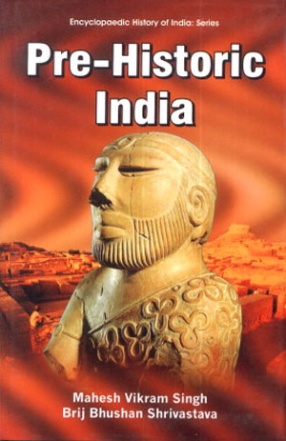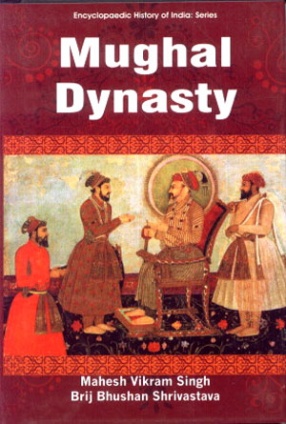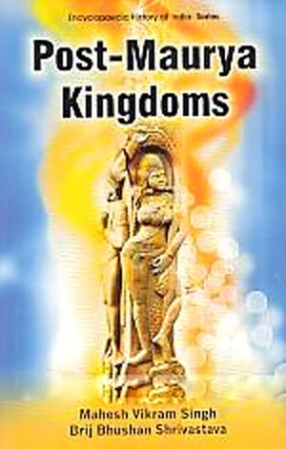Subtotal: $38.00

28 books






















Mughals contribution to India's art and culture was immense. Many Mughal emperors and princes encouraged literature. Some of them were themselves good writers. One of the valuable contributions of the Mughals was in architecture. Most of the Mughal Emperors commissioned the construction of magnificent buildings. Notable buildings belonging to the Mughal era are the Taj Mahal, Red Fort and Fatehpur Sikri. Their style of architecture was a blend of Islamic and ...

The Maratha Empire or the Maratha confederacy was located in the South West of present-day India. It existed from 1674 to 1818 and at its peak the empire’s territories covered much of South Asia. The empire was founded and consolidated by Shivaji Bhosale. After the death of Mughal Emperor Aurangzeb it expanded greatly under the rule of the Peshwas, the Prime Minister of the Maratha Empire. In 1761, the Maratha army lost the Third Battle of Panipat which ...

The Vedic Period is the period is the period during which the Vedas, the oldest sacred texts of the Indo-Aryans, were being composed. Scholars place the Vedic period in the second and first millennia BCE continuing up to the sixth century BC based on literary evidence. The associated culture, sometimes referred to as Vedic civilization, was centred in the northern and northwestern parts of the Indian subcontinent. Its early phase saw the formation kingdoms of ...

By 6th century B.C. the Brahmanic pretentions reached such ridiculous heights that Brahmins claimed to control the entire cosmos. This was based on the following logic: Vedic Gods controlled the Universe Yajnas compelled Gods to fulfill mans desires. Brahmins composed Mantras magical incantations uttered at Yajnas to delude Gods and therefore Brahmins controlled the Universe. Believing this Kshatriyas sacrificed grain ghee and animals to compel the Gods to grant ...

Clashes between the nobles and the Delhi Sultans marred the Sultanate from the beginning of its foundation. But, so long as the centre was powerful to retaliate, the rebellions were successfully crushed. Signs of physical disintegration were witnessed for the first time during Muhammad Tughluq’s reign in 1347 A.D. with the establishment of the Bahamani kingdom. But the Sultanate remained intact at least nearly for fifty years when finally the Timurid ...

Bhakti movement in medieval India is responsible for the many rites and rituals associated with the worship of God by Hindus Muslims and Sikhs of Indian subcontinent. For example Kirtan at a Hindu temple Qawalli at a Dargah by Muslims and singing of Gurbani at a Gurdwara are all derived from the Bhakti movement of medieval India 800-1700. The word Bhakti is derived from Bhakta meaning to serve honour revere love and adore. In the religious idiom it is attachment ...

A comparative analysis of Indus valley culture and Vedic culture would reveal the main features of ancient culture that shaped the Indian subcontinent. The focal centres of the Harappan culture remained for a long time the twin cities of Harappa and Mohenjo-daro and it is from these centres that Harappan culture budded off, whereas the focus of attention of the Rig Veda was the Punjab and in the later Vedic period it shifted to the Doab of the Ganges and Jamuna ...

Sentiments of Indian nationalism were expressed as early as 1885 at the Indian National Congress which was predominantly Hindu. In 1906 the All India Muslim League formed with favourable relations towards British rule but by 1913 that changed when the League shifted its focus and began to view Indian self government as its goal. It continued to favor Hindu Muslim unity towards that end for several decades but in 1940 the League began to call for a separate Muslim ...

The first Rajput kingdoms are attested in the 6th century, and the Rajputs rose to prominence in Indian history in the ninth and tenth centuries. The four Agni kula clans, the Pratiharas (Pariharas), Chauhans (Chahamanas), Solankis (Chaulukyas) and Paramaras (Parmars), rose to prominence first. The Pratiharas established the first Rajput kingdom in Marwar in southwestern Rajasthan, with the Chauhans at Ajmer in Central Rajasthan, the Solankis in Gujarat, and the ...

While much has been written on the Indian Freedom Movement as led by the Congress and Gandhi little is known of the numerous uprisings by peasants tribal communities princely states and other isolated revolutionary acts of resistance against British. Heroic acts of resistance against the British during 1763 to 1857 are almost unknown. The following is a listing of armed revolts that were brutally suppressed by the British as the East Indian Company consolidated ...

The prehistoric period in the history of humankind can roughly be calculated form 200000 BC to about 3500-2500 BC, when the first civilizations began to take shape. The history of India is no exception to the above-mentioned fact. The first modern human beings or the Homo sapiens set their foot on the Indian subcontinent anywhere between 200000 BC and 40000 BC and they soon spread throughout a large part of the subcontinent, including peninsular India. They ...

The Cholas are the earliest and the most ancient among the South Indian royal houses. The artifacts of the period found in South India mention Mahabharata as well as Ashokan edicts. The Chola Kingdom is very ancient, there has been references made in Mahabharata and even in Ashokan inscriptions. It is known that Karikala was the Chola ruler who reigned in the 2-century AD. During Karikala’s reign, the capital city was moved to Kaveripattanam from Uraiyur. ...

The end of the Vedic Age (1500 BC-600 BC) was followed by the rise of small kingdoms and republics in the Northern parts of India and especially in the Gangetic plains of Bihar. These small states later paved the way for large empires. The entrenchment of the caste system, which divided the society between the rulers and the ruled, also facilitated the rise of these states. Between the sixth and the fourth centuries BCE, Maghadha (in present day Bihar) became the ...

India had been without a major empire for almost a thousand years now, it had not been since the Gupta Dynasty that an all India empire had been created. The Mughal Dynasty was the last great empire of Indian history. Such was their greatness that not only did they leave a lasting impact on Indian history, the English word Mogul (derived from Mughal) means a powerful person. The Mughals were a remarkable dynasty, and at their peak they produced a successive set ...

The medieval Indian sub-continent was no more one society than was medieval Europe. In both locales, general trends can be seen across the region, but both lack one essential ingredient. What made Europe multiple kingdoms made India multiple kingdoms: neither culture had a social consciousness. The people of given areas didn’t conceive of themselves as part of some large India, some abstract that went beyond their immediate regions. Yes, there were ...

India has a rich and vast history, which has given the country a prominent place among the nations of the world. Its vibrant and varied culture, customs and traditions, world renewed monuments, has enriched the lives of the people dwelling in it. For better understanding it has been divided in to three era, namely ancient history, medieval history and modern history. The proletarian revolution presupposes practice and propagation of proletarian culture and values ...


Vedic literature refers to the earliest texts found in India, four books written in the Sanskrit language. Together they contain the basis for the Hindu religion. The four books are the Rig Veda (or Rgveda), Sama Veda, Yajur Veda and Atharva Veda. The earliest of the four was the Rig Veda, probably first composed about 1500 BC and codified between about 1200 and 800 BC, based on linguistic examination of the Sanskrit. Some scholars such as Stephan Levitt, ...

Modern Hinduism is divided into four major devotional sects: Vaishnavism, Shaivism, Shaktism and Smartism. Vaishnavism and Shaivism are generally regarded as monotheistic sects: each believes in one Supreme God, who is identified as Vishnu in Vaishnavism and Shiva in Shaivism. Vaishnavism, Shaivism and Shaktism are the most prevalent Hindu sects, among these, Vaishnavism is the largest. The devotional sects do not generally regard other sects as rivals, and each ...

Gautama Buddha lived between 563-483 BC and is highly regarded the world over by followers of other religious besides Buddhism, which was named after him. Buddha refers to the title given to the young prince Gautama Siddhartha and literally means the awakened one Gautama Buddha was called so after he attained enlightenment and salvation during his lifetime and spread the message through simple living and high thinking to his fellowmen and many generations after ...


Debate continues about the economic impact of British imperialism on India. The issue was actually raised by conservative British politician Edmund Burke who in the 1780s vehemently attacked the East India Company, claiming that Warren Hastings and other top officials had ruined the Indian economy and society. Indian historian Rajat Kanta Ray (1998) continues this line of attack, saying the new economy brought by the British in the 18th century was a form of ...

By the 10 century the Tuirks began invading India, bringing Islam to India. The Ghaznavis, a dynasty from eastern Afghanistan, began a series of raids into northwestern India at the end of the 10century. Mahmud of Ghazni the most notable ruler of this dynasty raided as far as present day Uttar Pradesh. Mahmud did not attempt to rule Indian Territory except for the Punjab area, which he annexed before his death in 1030. In 1175 one of the successors to ...

The Muslim rule in India lasted for almost 1000 years. How come then asked the British historian Sir Henry Elliot that Hindus has not left any account which could enable us to gauge the traumatic impact the Muslim conquest and rule had on them since there was none Elliot went on to produce his own eight volume history of India from its own historians 1867. His history claimed Hindus were slain for disputing with Muhammedans generally prohibited from ...
